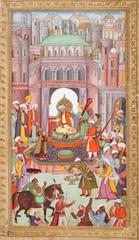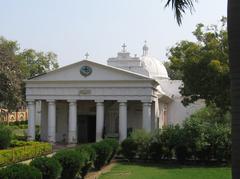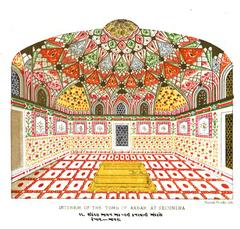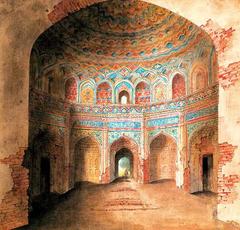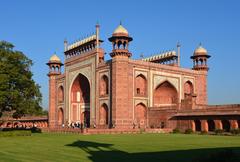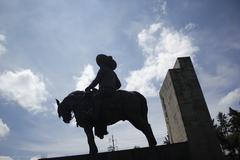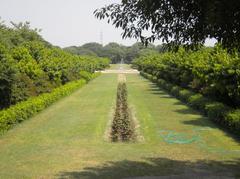Bateshwar Visiting Hours, Tickets, and Historical Sites Guide in Agra, Uttar Pradesh, India
Date: 04/07/2025
Introduction
Bateshwar, nestled on the tranquil banks of the Yamuna River near Agra in Uttar Pradesh, is a significant destination for travelers and pilgrims seeking a blend of history, spirituality, and rural Indian culture. Renowned for its ancient temple complex of over 100 Shiva temples dating back to the 8th–10th centuries CE, Bateshwar is a testament to centuries of religious harmony and architectural grandeur. The town’s name, derived from the legend of Lord Shiva—“Bat Ishwar” or “Lord of the Banyan”—reflects its deep mythological roots and sacred significance in both Hinduism and Jainism. It is also revered as the birthplace of Lord Neminath, the 22nd Jain Tirthankara.
Visitors to Bateshwar can expect to experience the spiritual ambiance of intricately carved sandstone temples, participate in daily rituals like abhishekam and aarti, and witness vibrant festivals such as the annual Bateshwar Fair. With its proximity to Agra and iconic sites like the Taj Mahal, Bateshwar is an ideal extension for travelers interested in exploring the rich cultural landscape of Uttar Pradesh.
For official details and further reading, consult the Archaeological Survey of India, Uttar Pradesh Tourism, and the Official Bateshwar Fair information.
Table of Contents
- Overview and Etymology
- Historical Development and Architecture
- Religious Significance
- Temple Visiting Hours and Ticket Information
- Getting to Bateshwar: Transportation
- The Annual Bateshwar Fair
- Nearby Attractions
- Accommodation and Dining
- Practical Tips and Local Customs
- Accessibility and Health
- Photography and Special Events
- Frequently Asked Questions (FAQ)
- Summary and References
Overview and Etymology
The name “Bateshwar” is rooted in Hindu mythology, referring to Lord Shiva resting beneath a banyan tree (“Bat” in Sanskrit). Over time, “Bat Ishwar” became “Bateshwar,” highlighting the town’s spiritual origins and its longstanding status as a sacred tirtha (pilgrimage site) for both Hindus and Jains.
Historical Development and Architecture
The Bateshwar temple complex comprises a series of shrines built between the 8th and 10th centuries CE. Although legend speaks of 101 temples, about 42 stand today, their spires and domes lining the riverbank in a striking visual sequence. These temples are primarily dedicated to Lord Shiva, but several honor other deities and Jain Tirthankaras, reflecting a history of religious coexistence.
Architecturally, the temples display classic North Indian elements: shikharas (curved temple towers), mandapas (pillared halls), and intricate stone carvings depicting mythological scenes and floral motifs. The temples’ sandstone pillars and riverfront ghats create a unique atmosphere, especially at sunrise and sunset (Seawater Sports; India in 360).
Religious Significance
Bateshwar is a revered pilgrimage destination. In Hinduism, it is believed that bathing in the Yamuna and worshipping at the temples earns spiritual merit and absolution of sins. In Jain tradition, Bateshwar—also known as Shauryapura—is honored as the birthplace of Lord Neminath. This dual significance draws devotees from both communities, making Bateshwar an important interfaith site (DharmikVibes).
Temple Visiting Hours and Ticket Information
- Visiting Hours: The temple complex is generally open from 5:00 AM to 8:00 PM. Hours may extend during major festivals.
- Entry Fees: Entry is free for all visitors. Donations are appreciated, and guided tours or special events may have nominal fees.
- Guided Tours: Local guides can be hired at the complex or in Bah town for deeper historical and cultural insights. It’s best to book guides in advance during peak seasons.
Getting to Bateshwar: Transportation
By Road
Bateshwar is approximately 70–72 km east of Agra (about 2 hours by car). The route is well-maintained and easily accessible by private car, taxi, or hired cab. State-run and private buses connect Agra to Bah, the nearest town (8 km from Bateshwar). From Bah, auto-rickshaws and shared jeeps take visitors to the temple complex (prayerpeak.com; tripoto.com).
By Train
The nearest major station is Agra Cantt. From there, taxis or buses complete the journey to Bateshwar. Bah station is closer but has limited train service.
By Air
Agra Airport (AGR) offers limited domestic flights. International visitors usually arrive via Delhi and continue by train or car to Agra, then onward to Bateshwar (tripoto.com).
Local Transport
Walking is the best way to explore the temple complex and ghats. During the annual fair, additional transport and signage are provided for visitors.
The Annual Bateshwar Fair
Held each year during the Kartik month (October–November), the Bateshwar Fair is one of North India’s largest livestock markets and a key religious event. Over 50,000 animals are traded, and thousands of devotees gather for ritual bathing, temple worship, and cultural festivities. Highlights include folk music, dance, equestrian events, handicraft bazaars, and regional cuisine (Festivation; Indian Holiday).
- Fair Duration: Typically runs for two to three weeks. In 2025, the fair is scheduled for October 18–24 (Indian Holiday).
- Tips: Dress modestly, carry cash, and consider staying in Agra due to limited accommodation in Bateshwar (Festivation).
Nearby Attractions
- Mathura (35 km): Birthplace of Lord Krishna, home to the Krishna Janmabhoomi Temple.
- Vrindavan: Renowned for its Krishna temples and vibrant festivals.
- Agra (100 km): Includes the Taj Mahal, Agra Fort, and Fatehpur Sikri.
- Chambal Wildlife Sanctuary: Offers river safaris to spot gharials, dolphins, and rare birds (Seawater Sports).
Accommodation and Dining
In Bateshwar
Accommodation is limited. The Rahi Tourist Bungalow (government-run) and several dharamshalas offer basic lodging, primarily for pilgrims. During the fair, temporary camps and shelters are set up (tripoto.com; prayerpeak.com).
Nearby Towns
Bah (8–12 km away) has small hotels and lodges suitable for short stays. Agra, a major tourist center, offers a full range of accommodations, from guesthouses to luxury hotels, and is the preferred base for many visitors.
Dining
Bateshwar’s eateries serve simple vegetarian North Indian cuisine. For more varied dining, visit Bah or Agra.
Practical Tips and Local Customs
- Best Time to Visit: October–March for pleasant weather and festivals.
- Dress Code: Modest clothing is essential; cover shoulders and knees.
- Footwear: Wear comfortable shoes that are easy to remove.
- Language: Hindi is widely spoken; English is understood in tourist areas.
- Essentials: Carry water, sunscreen, and required medications. Medical facilities are limited.
- Cash: ATMs are scarce; digital payments are uncommon.
Accessibility and Health
- Mobility: The temple complex features steps and uneven paths; temporary ramps are installed during festivals.
- Elderly/Disabled Visitors: Some assistance is available; plan accordingly.
- Health: Drink bottled or filtered water, use mosquito repellent, and carry a basic first aid kit. Major hospitals are in Agra.
Photography and Special Events
- Best Spots: Sunrise and sunset views of the temples along the ghats, fairground scenes, and intricate temple carvings.
- Permission: Always ask before photographing religious ceremonies or devotees.
- Events: Mahashivratri, Shravan Maas, and Nag Panchami are major festivals with special rituals (DharmikVibes).
Frequently Asked Questions (FAQ)
Q: What are the Bateshwar temple visiting hours?
A: Typically 5:00 AM–8:00 PM, with extended hours during festivals.
Q: Is there an entry fee?
A: Entry is free; donations are appreciated.
Q: How to reach Bateshwar from Agra?
A: By car, taxi, or bus to Bah, then auto-rickshaw or shared jeep to Bateshwar.
Q: Are guided tours available?
A: Yes, local guides are available at the temple complex and in Bah.
Q: Are accommodations available in Bateshwar?
A: Limited; Bah and Agra offer more comfortable options.
Summary
Bateshwar is a remarkable destination that offers a harmonious blend of ancient religious heritage, architectural beauty, and cultural vibrancy. Its 101 Shiva temples, sacred Jain sites, and the annual Bateshwar Fair create a multidimensional experience for pilgrims, history buffs, and travelers alike. Easy access from Agra, the opportunity for guided tours, and the chance to witness traditional rituals make Bateshwar a memorable addition to any Uttar Pradesh itinerary.
To plan your visit, check updated temple hours, consider staying in Agra for comfort, and respect local customs and the spiritual atmosphere of this unique town. For more information and practical tips, download the Audiala app and consult the official resources below.
References and Further Reading
- Archaeological Survey of India
- Uttar Pradesh Tourism
- Official Bateshwar Fair information
- Seawater Sports
- India in 360
- DharmikVibes
- prayerpeak.com
- tripoto.com
- Festivation
- holidify.com
Images and interactive maps of the Bateshwar temple complex and the annual fair are recommended for an enhanced trip-planning experience.
